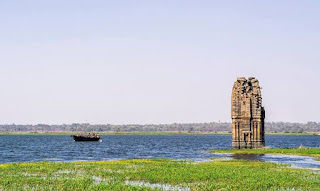Temples
Description by Beglar
In 1878, an Armenian-Indian archeologist Joseph David Beglar, gave the first ever description about the temples of Telkupi in his report to the Archaeological Survey of India. According to his report, the place was full of temples and the number was higher than any other place in the Chota Nagpur Plateau region. The temples were divided into three clusters, the largest group among them was situated to the north of Telkupi village near the Damodar river, the second group to the west of the village and the third group to the south-eastern part of the village.
First Group of Temples
No. 1: This south-facing temple, made of stone, was situated in the northernmost part of the first cluster, consisting of a single cell, with a lingam as the deity of worship inside, situated 2 feet (0.61 m) below the still of entrance. The temple was not much ornamented. Beglar noticed that the upper part of the temple was almost intact at the time of his report.
No. 2: This south-facing stone-made temple had a sculpture of Gajalakshmi over the entrance, with a lingam inside. Beglar found the upper portion of the temple broken and accumulated sand in the cell rose 6 inches (150 mm) of the still of entrance.
No. 3: This west-facing temple, with a lingam inside, was similar to No. 2 temple but Beglar found the upper portion missing and the sill of the entrance buried 4 feet (1.2 m) below accumulated rubbish.
No. 4: This east-facing almost-ruined temple had a sculpture of lotus over the entrance and a well-preserved four-armed statue of Vishnu was inside the temple as the deity of worship.
No. 5: This east-facing temple, had a sculpture of Ganesha over the entrance. Beglar found the upper portion of the temple missing.
(From Wikipedia)
